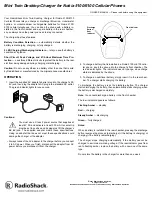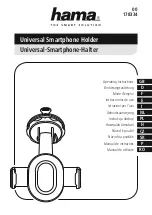
Safety
7
English
Safety
IMPORTANT
For the efficient and safe operation of
your wireless handheld portable
telephone, observe these guidelines.
Exposure To Radio Frequency Signals
Your wireless handheld portable telephone is a low power radio transmitter
and receiver. When it is ON, it receives and also sends out radio frequency (RF)
signals.
European and International agencies have set standards and
recommendations for the protection of public exposure to RF electromagnetic
energy.
•
International Commission on Non-Ionizing Radiation Protection (ICNIRP)
1996
•
Verband Deutscher Elektringenieure (VDE) DIN-0848
•
Directives of the European Community, Directorate General V in Matters of
Radio Frequency Electromagnetic Energy
•
National Radiological Protection Board of the United Kingdom, GS 11,
1988
•
American National Standards Institute (ANSI) IEEE.C95.1-1992
•
National Council on Radiation Protection and Measurements (NCRP).
Report 88
•
Department of Health and Welfare Canada. Safety Code 6
These standards are based on extensive scientific review. For example, over
120 scientists, engineers and physicians from universities, government health
agencies and industry reviewed the available body of research to develop the
updated ANSI Standard.
The design of your phone complies with these standards when used normally.
Antenna Care
Use only the supplied or approved replacement antenna. Unauthorised
antennas, modifications or attachments could damage the phone and may
violate FCC regulations.
Phone Operation
Normal Position:
Hold the phone as you would any other telephone with
the antenna pointed up and over your shoulder.
Tips on Efficient Operation:
For your phone to operate most efficiently:
•
Extend your antenna fully.
•
Do not touch the antenna unnecessarily when the phone is in use. Contact
with the antenna affects call quality and may cause the phone to operate
at a higher power level than otherwise needed.
Batteries
!
All batteries can cause property damage, injury or burns if a
conductive material such as jewellery, keys or beaded chains
touches exposed terminals. The material may complete an electrical
circuit and become quite hot. To protect against such unwanted
current drain, exercise care in handling any charged battery,
particularly when placing it inside your pocket, purse or other
container with metal objects. When the battery is detached from
the phone, your batteries are packed with a protective battery
cover; please use this cover for storing your batteries when not in
use.
Driving
Check the laws and regulations on the use of wireless telephones in the areas
where you drive. Always obey them. Also, if using your phone while driving,
please:
•
give full attention to driving - driving safely is your first responsibility
•
use hands-free operation, if available
•
pull off the road and park before making or answering a call if driving
conditions so require.
stac130.bk : safety.fm5 Page 7 Tuesday, May 12, 1998 4:27 PM
Summary of Contents for STAC130
Page 1: ...stac130 bk fcover fm5 Page 1 Tuesday May 12 1998 4 27 PM ...
Page 2: ...stac130 bk fcover fm5 Page 2 Tuesday May 12 1998 4 27 PM ...
Page 8: ...Introduction 4 English stac130 bk intro fm5 Page 4 Tuesday May 12 1998 4 27 PM ...
Page 14: ...Safety 10 English stac130 bk safety fm5 Page 10 Tuesday May 12 1998 4 27 PM ...
Page 40: ...Menu Navigation 36 English stac130 bk navigat fm5 Page 36 Tuesday May 12 1998 4 27 PM ...
Page 87: ...stac130 bk bcover fm5 Page 83 Tuesday May 12 1998 4 27 PM ...
Page 88: ...68P09414A03 stac130 bk bcover fm5 Page 84 Tuesday May 12 1998 4 27 PM ...












































